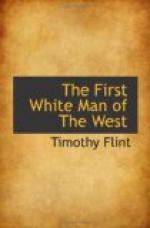About this time a new element began to exasperate and extend the ravages of Indian warfare, along the whole line of the frontier settlements. The war of Independence had already begun to rage. The influence and resources of Great Britain extended along the immense chain of our frontier, from the north-eastern part of Vermont and New York, all the way to the Mississippi. Nor did this nation, to her everlasting infamy, hesitate to engage these infuriate allies of the wilderness, whose known rule of warfare was indiscriminate vengeance; without reference to the age or sex of the foe, as auxiliaries in the war.
As this biographical sketch of the life of Boone is inseparably interwoven with this border scene of massacres, plunderings, burnings, and captivities, which swept the incipient northern and western settlements with desolation, it may not be amiss to take a brief retrospect of the state of these settlements at this conjuncture in the life of Boone.
CHAPTER VII.
Settlement of Harrodsburgh—Indian mode of besieging and warfare—Fortitude and privation of the Pioneers—The Indians attack Harrodsburgh and Boonesborough—Description of a Station—Attack of Bryant’s Station.
A road sufficient for the passage of pack horses in single file, had been opened from the settlements already commenced on Holston river to Boonesborough in Kentucky. It was an avenue which soon brought other adventurers, with their families to the settlement. On the northern frontier of the country, the broad and unbroken bosom of the Ohio opened an easy liquid highway of access to the country. The first spots selected as landing places and points of ingress into the country, were Limestone—now Maysville—at the mouth of Limestone creek, and Beargrass creek, where Louisville now stands. Boonesborough and Harrodsburgh were the only stations in Kentucky sufficiently strong to be safe from the incursions of the Indians; and even these places afforded no security a foot beyond the palisades. These two places were the central points towards which emigrants directed their course from Limestone and Louisville. The routes from these two places were often ambushed by the Indians. But notwithstanding the danger of approach to the new country, and the incessant exposure during the residence there, immigrants continued to arrive at the stations.
The first female white settlers of Harrodsburgh, were Mrs. Denton, McGary, and Hogan, who came with their husbands and families. A number of other families soon followed, among whom, in 1776, came Benjamin Logan, with his wife and family. These were all families of respectability and standing, and noted in the subsequent history of the country.




